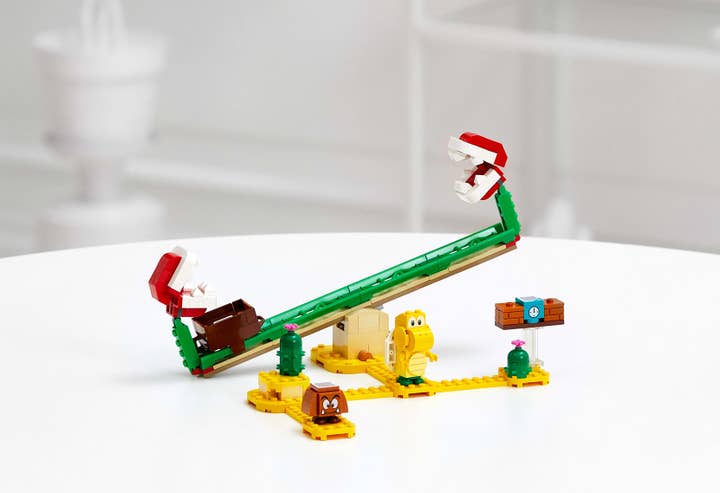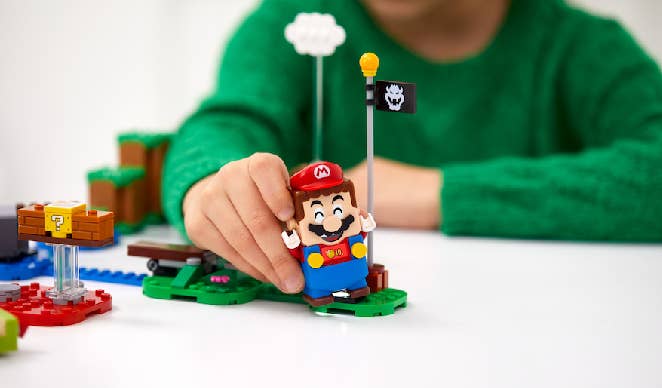Why it took five years to build Lego Super Mario
“The only brief was: do something that only these two companies could do together”
It's actually surprising that Lego and Nintendo, two icons of family entertainment, have never worked together before.
Warner Bros' various Lego video games are among a select group of third-party titles to have sold big on Nintendo consoles, whereas Nintendo's cast of characters have long proven themselves to be a licensing goldmine for toy companies. The two brands clearly match-up, which is why the news that Lego and Nintendo had collaborated on a Super Mario project was exciting.
The project, however, isn't what anyone had expected. It would have been easy -- and probably quite lucrative -- for Lego to put together some branded sets: blister packs of figures and a giant Peach's castle to build. You could even foresee a Lego video game featuring Mario and chums.
"About eight ideas were brought to the table -- all concrete directions"
But neither business was interested in the obvious. Instead, Lego Super Mario is an unusual amalgamation of toy and interactive entertainment. A bit like a physical version of Super Mario Maker, where families build their own levels and play around with an interactive toy Mario who reacts to movement and the blocks he lands on.
"The first talks started in the summer of 2015, when upper management met and had talks about whether we should collaborate," Lego design manager Jonathan Bennink tells GamesIndustry.biz. "At that level it's mostly about values, what you want to bring to the world, and see if you align in terms of morals. Then about eight ideas were brought to the table -- all concrete directions -- and one of them was this idea of an interactive figure. We had a range of them at the time, not just Mario.
"Both Nintendo and Lego management voted on the ideas and the one that got the most votes was the interactive figure, because it was one of the most original things that we saw in the line-up. It was something neither company had done before."

He continues: "The only brief my design team got was: do something that only these two companies could do together. It's a Lego product, but it's also a Nintendo product. It was never going to be a normal thing. Both companies have so many fans who have been asking for this for a while, and we felt like maybe they can wait a little bit longer but we will give them something new."
Bennink is no stranger to the world of video games. He was part of the team that worked on Lego Dimensions, which was the company's critically successful but commercially challenged toys-to-life project that ran for two years. Yet whereas Dimensions was about taking toys and bringing them to life in a game, Lego Super Mario works in reverse.
"It's funny that you say that, because rather than toys-to-life, we think this is life-to-toys," Bennink agrees. "We are bringing life to the Lego brick, you could say. That has definitely been the goal. We know that kids love video games and Lego, and finding a way to combine them... that's where the magic is.
"It's a Lego product, but it's also a Nintendo product. It was never going to be a normal thing"
"What we did with Dimensions was a good first step, but after you've done the building, the player is only then on the video game console. For this, we consciously made sure the core play loop is actually happening in the bricks. Where you're always touching the Lego brick with both hands, and it's very intuitive to play. There is a companion app where you can download updates for Mario and get instructions on how to play and to give inspiration for levels, but it's all in support of the play, rather than taking it over.
"We tried a concept where kids would have to complete levels in the app, and then they'd build it in that way... but it kind-of took all of the fun and the light-heartedness out of the building because kids were only completing levels in the app. We figured they did that enough in video games already. We felt that the fun here is being creative and building.
"That was something we had to learn the hard way, because we put a lot of effort into the other app where we made these levels. We scrapped everything and started again. But that's what happens. You learn."
The five-year journey to the Lego Super Mario collection is littered with abandoned concepts. And the biggest challenge was trying to work out "how to merge the Lego DNA with the Nintendo DNA."

"Fairly early on we knew we wanted an interactive character, but then what do you do? Initially we had this motion game where kids could run around the room with this figure, collect coins and jump. The kids were excited, but then we came out and presented it, and some of the management said: 'Yeah, but why is it Lego play?' Lego is about building and using your creativity. That jump from saying we have an idea of having an interactive figure, to why does it make sense for Lego to do? That has been the biggest challenge.
"Then we came up with this idea from one of the brainstorms that anything you build between the start and the finish is a level, and that evolved into you collecting coins in the level, then time limits, challenges to overcome..."
He continues: "A lot of these tech toys have a lot of initial appeal for a week, but then what? Longevity can come in different ways. We feel that the most Lego way is that it is intrinsically motivating that you just want to build something for Mario to try out. And then you share that with your families or friends or online, and inspire other people. And then you want to rebuild.
"We tried nailing these simple things that made it feel good to play, rather than adding all of these layers of complexity"
"Of course, then we had to figure out the play recipe, because you can't translate every game mechanic directly... For instance, you can put the start and finish next to each other and finish the level, and it's totally fine if you want to do that. In a game, you can stop people from doing certain things -- you can gate things -- but with Lego play you can do anything you want in any order. Initially, we had games where Mario had to go to certain colours, a bit like a board game, but that took the fun away because Mario was telling you what to do. Every time we added complexity to it, it became a worst experience.
"We have a lot of gestures or movements. And Nintendo said: 'why don't we just make walking fun?' So we spent about eight weeks just making him walk, so you can walk left to right and he reacts, and the same with jumping... do a small jump and he makes a half-sound, or a medium jump and you get this sound, or you high jump and it makes a bigger sound. So we just tried nailing these simple things that made it feel good to play, rather than adding all of these layers of complexity."
As well as making it fun to simply move Mario around, Bennink learned the best way to reward children for playing. He showed us the game's piranha plant slide, where users are challenged to move from left to right without touching the piranha plants. If you touch one of the enemies, you receive a time penalty, which means you can't collect coins for a period. Initially, the punishment for failure was more severe.

"We had situations where kids would get to the finish with minus 15 coins and they'd almost be crying," he explains. "So we learned to stimulate right behaviour, rather than punishing. If you go for a while without touching the plants, you get two coins at the same time, and then three coins... So you can get good at it, but it's not about punishing you."
Bennink worked closely with Nintendo veteran Takashi Tezuka on the project, one of the original creators of Super Mario Bros. Indeed, far from being a simple licensing partner, Nintendo was hands-on in the creation process.
"Hands-on is putting it very nicely," laughs Bennink. "They are just so passionate about anything they do. They care about what the consumer in the end feels more than anything else. They've been a part of making the play concept from the earliest sketches. Sometimes they would make a prototype, sometimes we would, and we'd ship them back and forth. They really did the essential thinking on what the play could be.
"They also helped us with the technology. We developed the sensor technology together, and now they are helping us go to market. It's been a rather unique collaboration for Lego, where we have been so close on everything that we do, including the packaging and the drop tests. In prototype they would drop it 6,000 times."
He continues: "Of course, there was this guy [shows us Lego Mario]. It took us well over a year to go from the idea of having this screen in a Mario to this character that was approved. It's a funky looking Mario, because he's square. That's because of the technology in him. Technology tends to be square -- with things like batteries, etc -- and also traditional Lego is square, so we felt it was a good fit. And then the cap... the cap of Mario is so important and iconic, it had to be the shape it is. Also, his belly, which overhangs there, is actually the shape of the Lego car hood. These little hair bits are the shape of Lego one-by-ones. We tried to make Mario out of Lego elements."
What Lego Super Mario isn't is a product designed for the adult fans of Lego or Mario. This is a family product. As such, there was significant pressure to ensure the price was right. The sensor technology combines barcodes with a basic optical sensor -- as opposed to RFID chips -- to keep the price down, and there was a constant fight between marketing and design over what features should end up on the cutting room floor. Even with the concessions, the Starter Set still ended up at the $60 price point, and that's before all the expansions.
But Bennink hopes the products will go down well with all sorts of fans, and that it will lead to further collaborations between Lego and Nintendo.
"Our generation, the millennials and those in their 40s, they grew up with Mario," he concludes. "They now have kids so, like Lego, it's a real family IP. We truly hope that we've made something that you will get as a family. We think that kids will want to spend their day making levels for their mums and dads to play. But of course, I can see that this isn't what some of the adult fans -- the collectors -- expected. But so far the response has been positive. People appreciate us for doing something new."

